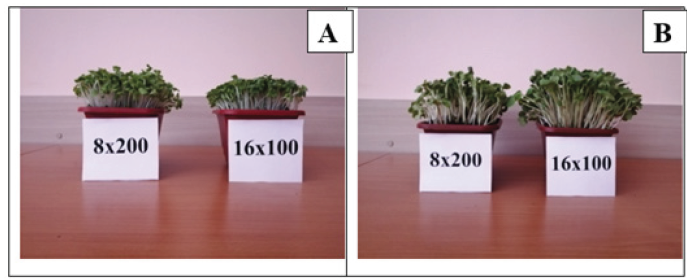- Submissions

Full Text
Modern Concepts & Developments in Agronomy
The Photoperiod/Light Intensity Ratio Affects the Yield of Microgreens Within One Daylight Integral
Filatov Dmitry1* and Vetchinnikov Alexander2
1Engineering Department, Russia
2Bioecology Department, Russia
*Corresponding author: Filatov Dmitry, Engineering Department, Nizhny Novgorod, Russia
Submission: July 19, 2022;Published: August 16, 2022

ISSN 2637-7659Volume11 Issue 2
Abstract
We present the results of two modes of illumination of microgreens when growing with photoperiod/ intensity ratios of 8/200 and 16/100 under equal daylight integrals. The modes of operation of the lighting system had different effects on both types of microgreens. A short photoperiod with high light intensity is a promising lighting mode that will allow the use of night hours of electricity consumption at low cost.
Keywords: Light intensity; Photoperiod; Fresh weight; Dry weight; Microgreens
Introduction
Microgreens have a higher content of useful phytochemicals than for their mature plants [1], as well as a short growing period of 7-10 days. The level of Photocytotic Photon Flux (PPFD) and photoperiod are important in growing microgreens. Analysis of studies [2-6] shows that the effective PPFD for microgreens is in the range of 100-200μmol·m-2·s-1. Presumably, the variation in the intensity value is due to the different photoperiod in the experiments (from 8 to 20 hours/day). The purpose of this study is to determine the best ratio of light intensity and photoperiod within one daylight integral, as well as to determine the ratio of red and blue light in the presence of far-red spectrum, taking into account the differential tariff for electricity.
Materials and Methods
The studies were conducted in an enclosed chamber without access to natural light. The air temperature during the experiment was 23-26 °C with a relative humidity of 50-60%. Growing period of microgreens was 7 days for radish and 9 days for cabbage. Microgreen cabbage “Mitsuna” and radish “Octava” plants were planted in pots (160x100x80mm) with peat. Irrigation was carried out once a day. We started to use artificial lighting from the first day. For illumination were used LED units with the ratio of colors in the total spectrum blue (B): red (R): far red (FR)=27.3%:57.7%:15%. Two irradiation methods were compared with a photoperiod/intensity ratio of 8/200 and 16/100 within an equal daylight integral.
Results and Discussion
The lighting regimes had different effects on both microgreens (Figure 1). The average fresh weight of cabbage microgreens was 41.45g/pot and 30.52g/pot at photoperiods of 8 and 16 hours, respectively (light intensities of 200 and 100μmol·m-2·s-1). The average fresh weight of radish microgreens was 25.53g/pot and 50.52g/pot at photoperiods of 8 and 16 hours, respectively (light intensity 200 and 100μmol·m-2·s-1). The average dry weight of the cabbage microgreens was 2.30g/pot and 2.19g/pot at photoperiods of 8 and 16 hours, respectively. The average dry weight of radish microgreens was 1.42g/pot and 3.63g/pot at photoperiods of 8 and 16h, respectively (light intensity 200 and 100μmol·m-2·s-1). In studies [7,8], extension of photoperiod and reduction of PPFD increased the growth of fresh and dry weight of lettuce and mizuna.
Figure 1:Appearance of microgreen cabbage (A) and radish (B) crops.

Perspective
The study showed that the photoperiod/light intensity ratio has different effects on different varieties of microgreens. A promising way to illuminate microgreens in their cultivation is an 8-hour photoperiod at a light intensity of 200μmol·m-2·s-1. A short photoperiod with high light intensity will allow the use of night hours of electricity consumption at low cost, which will reduce the financial cost in the cost of production.
References
- Xiao Z, Rausch SR, Luo Y, Sun J, Yu L, et al. (2019) Microgreens of Brassicaceae: Genetic diversity of phytochemical concentrations and antioxidant capacity. LWT 101: 731-737.
- Johnson RE, Kong Y, Zheng Y (2019) Elongation growth mediated by blue light varies with light intensities and plant species: A comparison with red light in arugula and mustard seedlings. Environmental and Experimental Botany 169.
- Vetchinnikov AA, Filatov DA, Olonina SI, Kazakov AV, Olonin IY (2021) Influence of the radiation intensity of LED light sources of the red-blue spectrum on the yield and energy consumption of microgreens. IOP Conference Series: Earth and Environmental Science 723: 1-7.
- Samuolienė G, Brazaitytė A, Jankauskienė J, Viršilė A, Sirtautas R, et al. (2013) LED irradiance level affects growth and nutritional quality of Brassica Open Life Sciences 8(12): 1241-1249.
- Brazaitytė A, Sakalauskienė S, Samuolienė G, Jankauskienė J, Viršilė A, et al. (2015) The effects of LED illumination spectra and intensity on carotenoid content in Brassicaceae microgreens. Food Chemistry 173: 600-606.
- Gao M, He R, Shi R, Zhang Y, Song S, et al. (2021) Differential effects of low light intensity on broccoli microgreens growth and phytochemicals. Agronomy 11(3): 537.
- Kelly N, Choe D, Meng Q, Runkle ES (2020) Promotion of lettuce growth under an increasing daily light integral depends on the combination of the photosynthetic photon flux density and photoperiod. Scientia Horticulturae 272.
- Palmer S, Iersel MW (2020) Increasing growth of lettuce and mizuna under sole-source LED lighting using longer photoperiods with the same daily light integral. Agronomy 10(11): 1659.
© 2022 Tulio Silva Lara. This is an open access article distributed under the terms of the Creative Commons Attribution License , which permits unrestricted use, distribution, and build upon your work non-commercially.
 a Creative Commons Attribution 4.0 International License. Based on a work at www.crimsonpublishers.com.
Best viewed in
a Creative Commons Attribution 4.0 International License. Based on a work at www.crimsonpublishers.com.
Best viewed in 







.jpg)






























 Editorial Board Registrations
Editorial Board Registrations Submit your Article
Submit your Article Refer a Friend
Refer a Friend Advertise With Us
Advertise With Us
.jpg)






.jpg)














.bmp)
.jpg)
.png)
.jpg)










.jpg)






.png)

.png)



.png)






